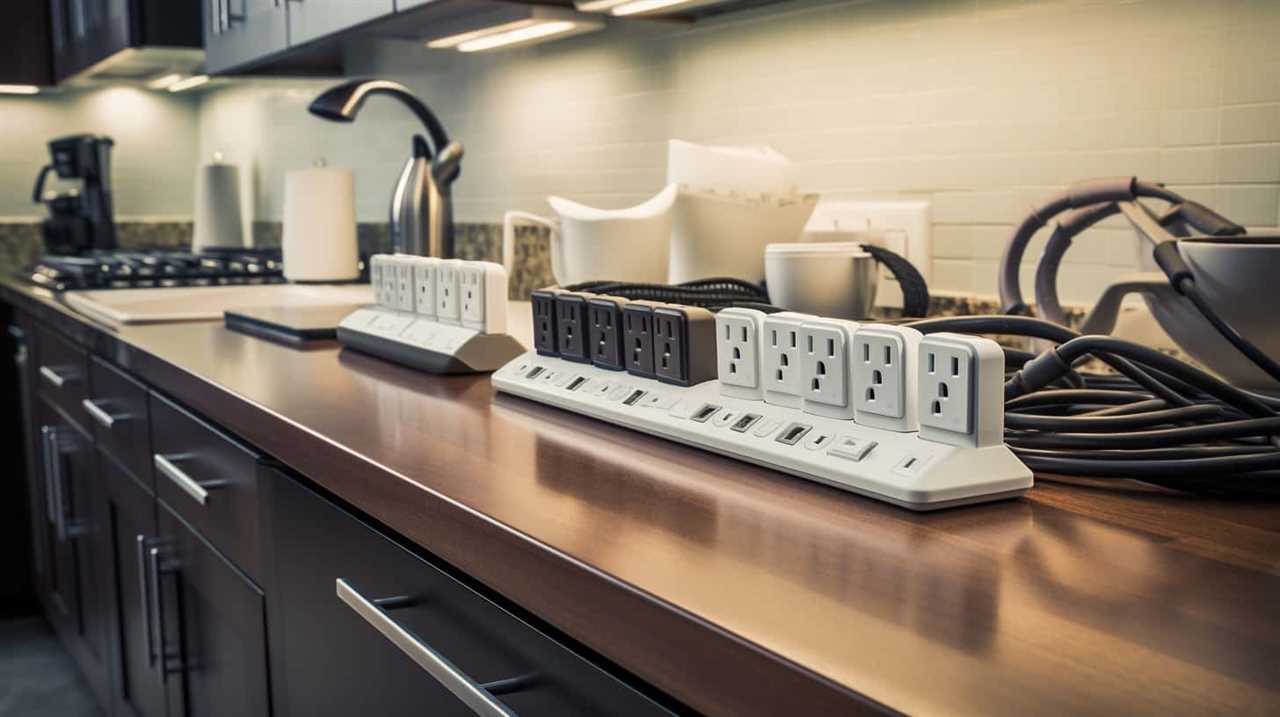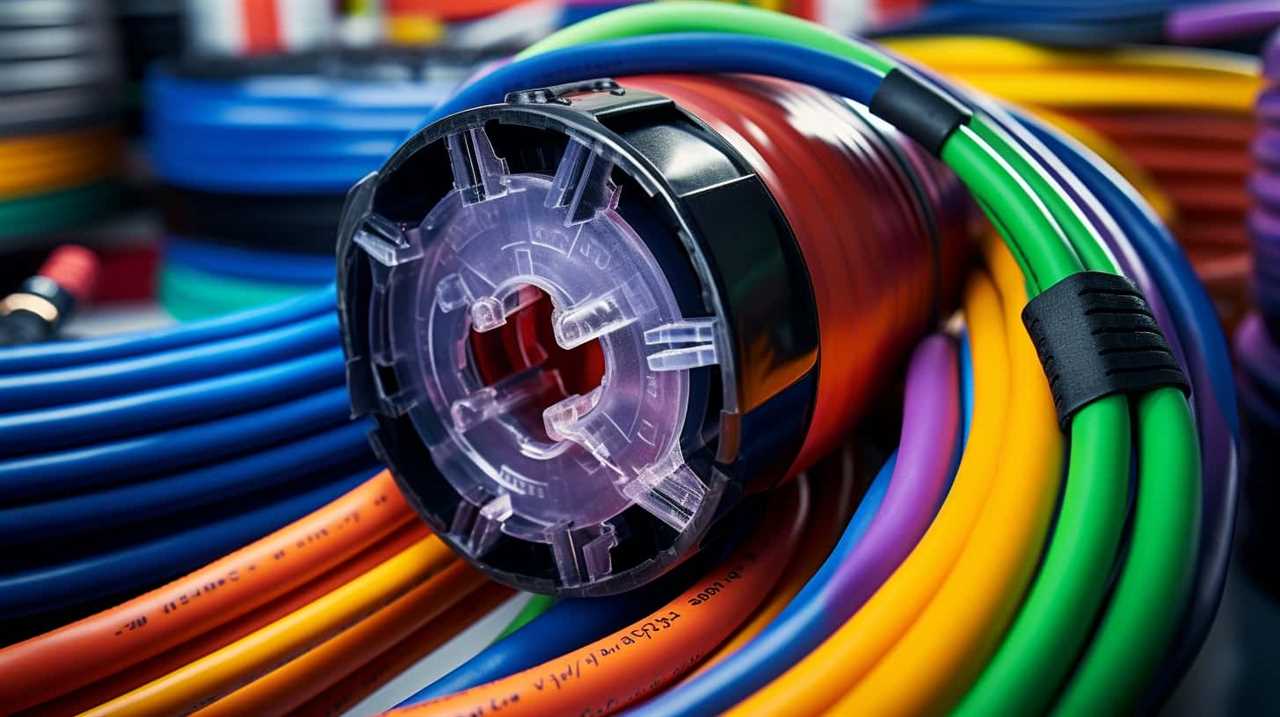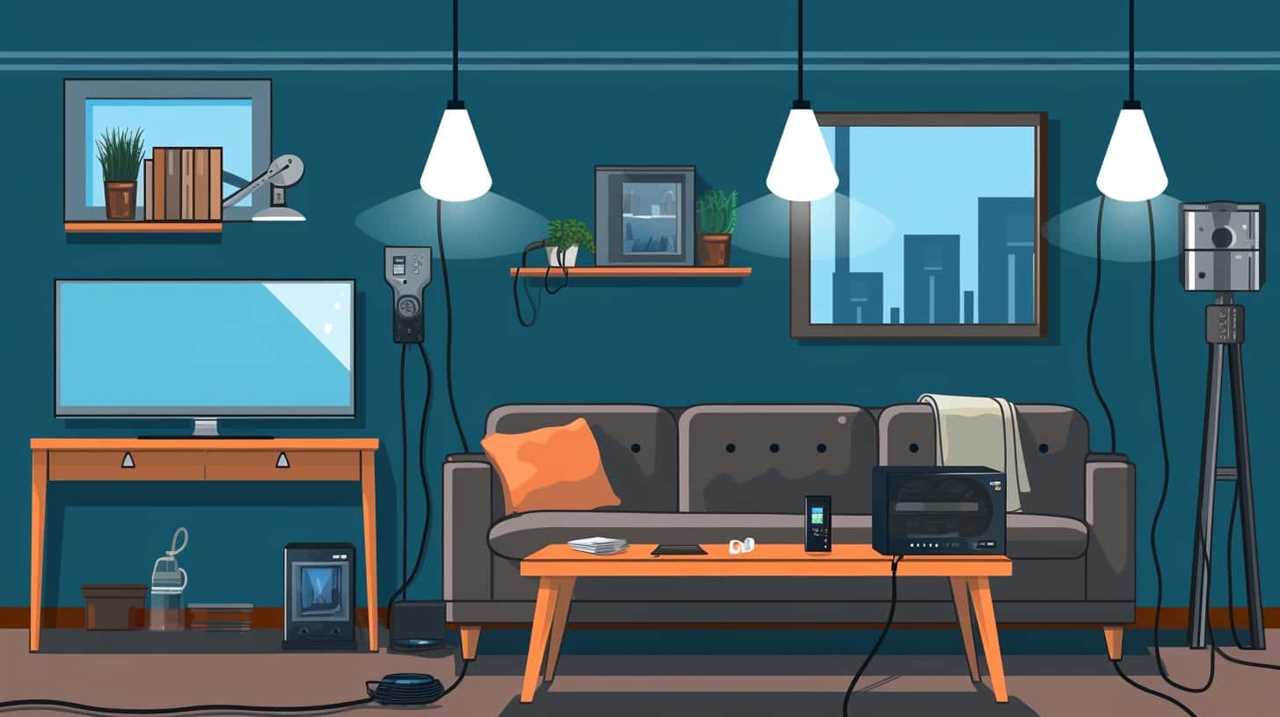You might be wondering, ‘Can high voltage harm my devices?’ The answer is affirmative, and we’re here to clarify why.
Understanding the potential risks and how high voltage can cause damage is crucial for safeguarding your valuable appliances.
From common appliances at risk to the importance of surge protectors and grounding, we’ll provide you with the knowledge you need to protect your appliances during power surges.
So, let’s dive into the world of high voltage and appliance safety.

Key Takeaways
- High voltage can cause damage to appliances through overheating, component failure, and electrical surges.
- Signs of high voltage damage include flickering lights, frequent appliance malfunctions, and burn marks on outlets.
- High voltage can lead to overworking of refrigerator compressors, damage to air conditioner compressors, irreparable damage to sensitive electronic components, and a decrease in energy efficiency.
- Protection measures against high voltage damage include using surge protectors and voltage stabilizers, regular maintenance checks, using grounded outlets and surge protectors with indicator lights, and unplugging appliances during storms.
Understanding High Voltage
We will explore how high voltage can potentially harm appliances. Understanding electrical currents is essential in comprehending the dangers of high voltage. Electrical current refers to the flow of electric charge in a circuit. It’s measured in amperes.
High voltage, on the other hand, refers to the amount of electrical potential energy present in a circuit. It’s measured in volts. To ensure high voltage safety, precautions must be taken. These include using proper insulation and grounding techniques, using protective equipment such as gloves and goggles, and following electrical codes and regulations.
Potential Risks to Appliances
Appliances can be at risk of damage when exposed to high voltage. It is important to understand the potential risks associated with high voltage to ensure the longevity and functionality of our appliances. Here are some key risks to be aware of:
| Risk | Prevention | Insurance Coverage |
|---|---|---|
| Overheating | Regular maintenance, proper ventilation | Some policies may cover appliance damage caused by power surges |
| Short-circuiting | Avoid overloading circuits, use surge protectors | Check your policy for coverage on appliance damage due to electrical issues |
| Component failure | Avoid power fluctuations, use voltage stabilizers | Some policies may include coverage for appliance damage due to electrical faults |
| Electrical fires | Regular inspection, use of circuit breakers and fuses | Verify if your policy covers appliance damage caused by fire |
| Total appliance malfunction | Follow manufacturer guidelines, avoid incorrect voltage usage | Confirm if your policy offers coverage for appliance damage due to high voltage |
Understanding these risks and taking necessary precautions such as power surge prevention and checking insurance coverage for appliance damage can help mitigate potential issues. Now, let’s delve into how high voltage can cause damage to our appliances.

How High Voltage Can Cause Damage
To understand the potential damage caused by high voltage, it’s crucial to examine its impact on the internal components of our appliances. High voltage dangers can wreak havoc on our appliances, leading to costly repairs or even complete breakdowns. Here are three ways in which high voltage can cause damage:
- Overheating: Excessive voltage can cause the electrical circuits and components within an appliance to overheat. This can result in burnt wires, melted insulation, and even fires.
- Component failure: High voltage can overload and damage sensitive electronic components, such as integrated circuits and transistors. This can lead to a loss of functionality or complete failure of the appliance.
- Electrical surges: Voltage spikes caused by power surges can occur due to lightning strikes, faulty wiring, or utility company issues. These surges can instantly destroy the internal components of appliances, rendering them unusable.
Understanding these high voltage dangers highlights the importance of taking electrical safety precautions to protect our appliances.
Now, let’s explore the signs of high voltage damage and how to address them.
Signs of High Voltage Damage
As we explore the signs of high voltage damage, it’s important to note that flickering lights can indicate potential issues. This could be a sign that the voltage is fluctuating and putting strain on the electrical system.

Additionally, frequent appliance malfunctions, such as sudden shutdowns or overheating, may also be indicative of high voltage damage.
Lastly, burn marks on outlets can suggest that excessive voltage has caused damage to the electrical wiring.
Being aware of these signs can help us identify and address potential high voltage damage to our appliances.
Flickering Lights Indicate Damage
Our experience with flickering lights has shown us that high voltage can indeed cause damage to electrical appliances. When lights flicker, it’s often a sign of an unstable electrical supply, which can lead to power surges. These power surges, characterized by sudden increases in voltage, can be detrimental to appliances and electronic devices.

Here are three reasons why flickering lights indicate damage:
- Increased stress on electrical components: Frequent power surges put excessive strain on the internal components of appliances, leading to premature wear and tear.
- Malfunctioning electronics: Power surges can disrupt the delicate circuitry within appliances, causing them to malfunction or even fail completely.
- Reduced lifespan: Appliances exposed to frequent power surges may experience shortened lifespans due to the cumulative damage inflicted on their internal mechanisms.
Understanding the relationship between flickering lights and power surge risks is crucial in protecting your valuable appliances from potential damage.
Frequent Appliance Malfunctions
In our experience, frequent appliance malfunctions are clear signs of high voltage damage. When appliances require frequent repairs, it suggests that there may be an issue with the electrical supply. This can be caused by high voltage levels, which can damage the internal components of the appliance.
To troubleshoot these issues, it’s important to check the electrical connections and ensure that they’re secure. Additionally, using a voltage meter can help identify if the appliance is receiving an excessive amount of voltage. If high voltage is detected, it’s recommended to contact a qualified electrician to resolve the issue and prevent further damage to the appliance.

Taking these troubleshooting tips into consideration can help prevent future malfunctions and prolong the lifespan of your appliances.
Burn Marks on Outlets
We’ve noticed that burn marks on outlets are a clear indication of high voltage damage. When it comes to identifying voltage fluctuations that can cause these burn marks, there are a few key signs to look out for:
- Discoloration: Burn marks on outlets often appear as dark or blackened spots, indicating excessive heat and damage.
- Smell: A burnt or smoky odor near the outlet can be a strong indication of high voltage damage.
- Flickering lights: If you notice that the lights in your home are constantly flickering, it may be a sign of voltage fluctuations that can lead to burn marks on outlets.
These burn marks shouldn’t be ignored, as they can pose serious safety hazards.
Now, let’s move on to discussing the common appliances at risk of high voltage damage.

Common Appliances at Risk
When it comes to high voltage and appliances, there are several common appliances that are at risk of potential damage. These appliances include refrigerators, air conditioners, televisions, computers, and washing machines, among others.
The high voltage can cause irreversible damage to the sensitive electronic components of these appliances, leading to costly repairs or even complete malfunction. Therefore, it’s crucial to take necessary protection measures, such as using surge protectors and voltage regulators, to safeguard these appliances from the risks posed by high voltage.
Voltage and Appliances
Our research has identified several common appliances that are at risk of being damaged by high voltage. Understanding voltage fluctuations is crucial in protecting these appliances and ensuring their longevity. Here are three items to consider:
- Refrigerators: High voltage can cause the compressor to overwork, leading to premature failure and a decrease in energy efficiency.
- Air conditioners: Excessive voltage can damage the compressor, resulting in a significant decrease in cooling capacity and higher energy consumption.
- Computers and electronics: High voltage can cause irreparable damage to sensitive electronic components, leading to system failure and potential data loss.
It is important to note that high voltage not only poses a risk of damage to appliances but also impacts their energy efficiency.

Now, let’s delve into the potential damage risks associated with high voltage.
Potential Damage Risks
To understand the potential damage risks associated with high voltage, let’s explore the appliances most commonly at risk. Understanding electrical currents and taking safety precautions are essential in preventing damage to these appliances.
One of the most vulnerable appliances is the refrigerator. High voltage can cause damage to its delicate compressor and motor, leading to a malfunction. Similarly, air conditioners are at risk due to their complex electrical components, such as the compressor and condenser. Excessive voltage can damage these parts, resulting in costly repairs.
Washing machines and dryers are also susceptible to high voltage damage. The motors and control boards in these appliances can be affected, leading to operational issues. Additionally, televisions, computers, and other electronics with sensitive circuitry can suffer irreparable damage when exposed to high voltage.

To safeguard against potential damage, it’s crucial to install surge protectors and voltage stabilizers. These devices help regulate and stabilize the incoming electrical current, protecting appliances from voltage fluctuations. Regular maintenance and inspections by qualified professionals are also recommended to ensure the longevity of your appliances.
Protection Measures Needed
To protect our common household appliances at risk from high voltage damage, we need to implement appropriate protection measures. Here are three tips for voltage regulation and common causes of high voltage:
- Surge protectors: Investing in surge protectors can help prevent voltage spikes from reaching your appliances. Surge protectors act as a barrier, diverting excess voltage away from your devices and ensuring their safety.
- Voltage regulators: Installing voltage regulators can help stabilize the voltage supply to your appliances. These devices automatically adjust the incoming voltage to a safe level, preventing any damage that could be caused by high or low voltage.
- Regular maintenance: Conducting regular maintenance checks on your appliances and electrical systems can help identify and resolve any potential issues. This includes inspecting wiring, outlets, and circuit breakers to ensure they’re in proper working condition.
Tips to Protect Your Appliances
We can safeguard our appliances by implementing surge protection measures. Here are some tips for maintenance and power surge prevention to protect your valuable appliances:
| Tip | Description |
|---|---|
| Install Surge Protectors | Use surge protectors with built-in circuit breakers to protect appliances from power surges. Make sure they have a high joule rating and indicator lights. |
| Unplug During Storms | Disconnect appliances during thunderstorms to avoid damage from lightning strikes or power surges caused by disruptions in the electrical grid. |
| Regular Inspections | Schedule regular inspections by a qualified electrician to ensure proper grounding and identify any potential issues with your electrical system. |
Importance of Surge Protectors
Surge protectors play a crucial role in safeguarding our appliances from the damaging effects of high voltage. Understanding power fluctuations and the benefits of using voltage stabilizers can help us appreciate the importance of surge protectors.

Surge protectors prevent voltage spikes: They detect sudden increases in voltage and divert excess electricity away from our appliances. This prevents damage caused by power surges.
Surge protectors absorb excess voltage: By absorbing and dissipating excess voltage, surge protectors protect our appliances from voltage fluctuations. This helps to maintain a stable and safe operating voltage.
Surge protectors provide multiple outlets: Surge protectors not only protect our appliances but also allow us to connect multiple devices to a single power source. This ensures that all connected devices are equally protected.
The Role of Grounding in Appliance Safety
Grounding plays a fundamental role in ensuring the safety of our appliances. It’s an essential aspect of electrical safety that prevents electric shocks and protects both individuals and equipment from potential harm.

The role of grounding is to provide a safe pathway for electrical current to flow into the ground, thereby minimizing the risk of electric shock. In the event of a fault or electrical surge, grounding provides an alternative path for the excess electrical energy to dissipate, preventing damage to appliances.
Without proper grounding, electrical faults can result in serious injury or even death. Appliances that are properly grounded are less likely to experience electrical malfunctions or damage due to high voltage. Therefore, ensuring the role of grounding is understood and implemented correctly is crucial for maintaining the safety and longevity of our appliances.
Steps to Take During Power Surges
When it comes to power surges, there are several steps we can take to protect our appliances and electronics.
One of the first things to consider is investing in surge protectors, which can help regulate the voltage and prevent damage.

Additionally, during a power surge, it’s advisable to unplug sensitive electronics to avoid any potential harm.
Surge Protectors Explained
During a power surge, we should always plug our appliances into surge protectors to safeguard against potential damage caused by high voltage. Surge protectors are essential devices that offer protection against power surges and ensure the safety of our valuable electronic equipment.
Here are three key features of surge protectors that everyone should understand:
- Voltage Clamping: Surge protectors are designed to limit the voltage supplied to our appliances during a power surge. They’ve a clamping voltage, which is the maximum voltage the protector allows to pass through. This feature prevents excessive voltage from reaching our devices and damaging them.
- Joule Rating: Surge protectors also have a joule rating, which indicates their capacity to absorb energy from power surges. The higher the joule rating, the more energy the protector can handle. Choosing a surge protector with a higher joule rating provides better protection for our appliances.
- Response Time: Surge protectors have a response time, which is the time it takes for the protector to start diverting excess voltage away from our devices. A faster response time means the protector can react quickly to power surges, minimizing the risk of damage to our appliances.
Unplugging During Surges
To ensure the safety of our appliances during power surges, we need to take proactive steps such as unplugging them from the electrical outlet. Unplugging precautions play a crucial role in surge damage prevention.

When a power surge occurs, it can send a sudden rush of electricity through the electrical system, potentially damaging any connected appliances. Unplugging the appliances during a surge eliminates the risk of them being affected by the excess voltage.
It’s important to note that surge protectors alone may not always provide sufficient protection, as they can still allow some voltage to pass through. By unplugging our appliances, we’re taking a proactive approach to safeguarding them from potential damage caused by power surges.
Protecting Sensitive Electronics
We can further protect our sensitive electronics from power surges by implementing a few additional steps. Here are three important measures to consider:
- Use Surge Protectors: Investing in high-quality surge protectors can provide an extra layer of defense against power surges. These devices are designed to detect and divert excess voltage away from your electronics, safeguarding them from potential damage.
- Install Voltage Regulators: Voltage regulators are essential for maintaining a steady and safe level of electrical power. By regulating the voltage, these devices prevent sudden spikes or drops that can harm sensitive electronics. They’re particularly crucial for devices that require a stable power supply, such as computers, servers, and audiovisual equipment.
- Consider Uninterruptible Power Supplies (UPS): UPS units not only protect against power surges but also provide a backup power source during outages. These devices offer a brief window to safely shut down equipment and prevent data loss. Additionally, they provide continuous power, protecting sensitive electronics from voltage fluctuations and ensuring uninterrupted operation.
Conclusion: Safeguarding Your Appliances
Let’s wrap up by discussing how to safeguard our appliances against high voltage. One of the most important safety precautions is to ensure proper electrical maintenance. Regular inspections and maintenance checks can help identify any potential issues before they become major problems. Here are some key steps to protect your appliances:

| S.NO | SAFETY PRECAUTIONS |
|---|---|
| 1 | Use surge protectors |
| 2 | Install voltage stabilizers |
| 3 | Avoid overloading electrical circuits |
Using surge protectors is essential as they can divert excess voltage away from your appliances, preventing damage. Additionally, installing voltage stabilizers can regulate the voltage supply and protect your appliances from sudden voltage fluctuations. Finally, avoiding overloading electrical circuits is crucial to prevent overheating and potential damage. By following these safety precautions and performing regular electrical maintenance, you can ensure the longevity and optimal performance of your appliances.
Frequently Asked Questions
Are All Appliances Equally at Risk of Being Damaged by High Voltage?
All appliances are not equally at risk of high voltage damage. There are various risk factors that determine susceptibility, such as age, quality, and design. Taking protective measures, such as using surge protectors, can mitigate potential damage.
Can High Voltage Damage Appliances Even if They Are Turned Off?
High voltage can damage appliances even when turned off. To prevent high voltage damage, use surge protectors or unplug appliances during power surges. Consult a professional for further guidance.
What Are the Long-Term Effects of High Voltage Damage on Appliances?
Long-term consequences of high voltage damage on appliances include decreased lifespan and increased risk of malfunction. Preventive measures such as using surge protectors and regular maintenance can mitigate these effects.

Is It Possible to Repair Appliances That Have Been Damaged by High Voltage?
It is possible to repair appliances damaged by high voltage. To prevent high voltage damage, use surge protectors and avoid overloading circuits. Regular maintenance can also help identify and address potential issues before they cause extensive damage.
How Can I Check if My Appliance Has Been Damaged by High Voltage?
To check for voltage damage, we can inspect the appliance for signs such as burnt smells, melted wires, or blackened components. It’s crucial to assess these indicators carefully to determine the extent of the damage.
Conclusion
In conclusion, safeguarding our appliances from high voltage is of utmost importance.
Like a shield protecting a knight in battle, surge protectors act as a barrier against the potential damage caused by power surges.

Grounding our appliances provides them with a solid foundation, grounding them like the roots of a mighty tree.
By taking these steps, we can ensure the longevity and functionality of our beloved appliances, keeping them safe from the dangers of high voltage.










